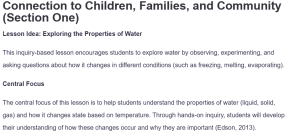Connection to Children, Families, and Community (Section One)
Lesson Idea: Exploring the Properties of Water
This inquiry-based lesson encourages students to explore water by observing, experimenting, and asking questions about how it changes in different conditions (such as freezing, melting, evaporating).
Central Focus
The central focus of this lesson is to help students understand the properties of water (liquid, solid, gas) and how it changes state based on temperature. Through hands-on inquiry, students will develop their understanding of how these changes occur and why they are important (Edson, 2013).
Connection to Students’ Expressed Interests and Curiosity
Kindergarten students are naturally curious about the world around them, and water is something they interact with every day. This lesson taps into their everyday experiences with water (for example. playing with water, ice, and steam) and encourages them to investigate its properties further.
Prior Knowledge
Students will have prior experiences with water in their daily lives, such as drinking water, seeing ice in their drinks, or watching steam when cooking. These observations will serve as the foundation for understanding water’s different states.
Personal/Cultural Assets
Many students come from diverse backgrounds where water plays different roles in their cultural or daily lives, such as in cooking, cleaning, or recreational activities. This lesson can connect to those experiences by discussing how water is used in different environments and cultures, reinforcing their personal connection to the material.
Connection to Family/Community
This lesson extends to family and community by encouraging students to explore the role of water at home, whether observing water in a cup, watching ice cubes melt, or noticing condensation on a window. Students can involve family members in simple water experiments, making the lesson relevant to their home life.
References
Edson, M. T. (2013). Starting with science: Strategies for introducing young children to inquiry. Stenhouse Publishers.
ORDER A PLAGIARISM-FREE PAPER HERE
We’ll write everything from scratch
Question 
Connection to Children, Families & Community (Section One)
- In 1-2 sentences, state the central focus of this lesson. (The central focus is a description of the important understandings and core concepts that you want students to develop within the learning segment.) Remember that this is a science lesson and you should be sure that the focus is inquiry based and takes into account the 8 practices of science.
- How is this lesson connected to students’ expressed interests and curiosity?
c.) What prior knowledge will students need and/or have that will strengthen their learning in this specific lesson?
d.) What personal/cultural assets do students possess that will strengthen their learning in this specific lesson?
e.) How will this lesson connect/extend to children’s family/community experiences?

Connection to Children, Families, and Community (Section One)
SO, USING MY CLASS TEXTBOOK WHICH IS LISTED BELOW YOU HAVE TO CHOOSE A LESSON THAT YOU WILL BE ABLE TO DO WITH KIDERGARTEN STUDENTS AND ALSO BE ABLE TO PROVIDE STUDENT WORK PLEASE DO NOT CHOOSE A LESSON WHERE YOU CANNOT PROVIDE THE STUDENT WORK FOR IT. THIS LESSON PLAN WILL BE BROKEN UP INTO 6 PARTS THIS IS PARTS THIS WEEK ONLY PART ONE IS DUE MY PROFFESSOR WANTS TO KNOW WHAT LESSON I WILL BE DOING OUT OF THE TEXTBOOK AND TO ANSWER QUESTIONS A-E ONCE I CHOOSE THE L.ESSON I WILL LIKE TO DO. BUT, YOU HAVE TO CHOOSE A LESSON WHERE YOU ARE GOING TO BE ABLE TO PROVIDE STUDENT WORK. THROUGHOUT THE WEEKS WILL BE UPLOADING THE OTHER PARTS OF TIS LESSON PLAN AND THAT IS WHEN I WILL NEED YOU TO PROVIDE THE STUDENT WORK. BUT AS FOR PART ONE MY PROFESSOR JUST WANTS TO KNOW THE LESSON ILL BE DOING AND ANSWER QUESTIONS A-E.
CLASS TEXTBOOK: Starting with Science – Strategies for Introducing Young Children to Inquiry by Marcia Talhelm Edson; Stenhouse Publishers, 2013